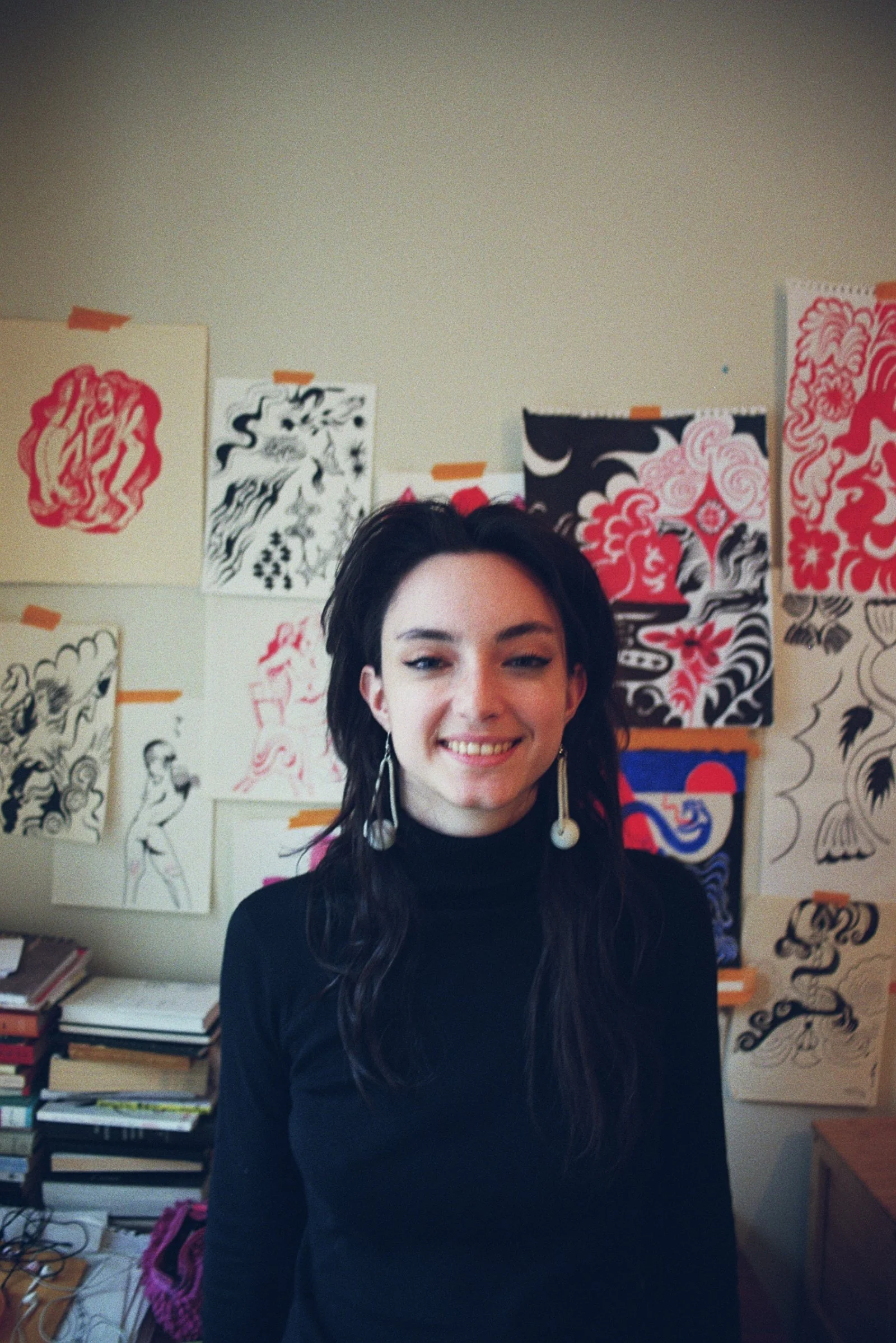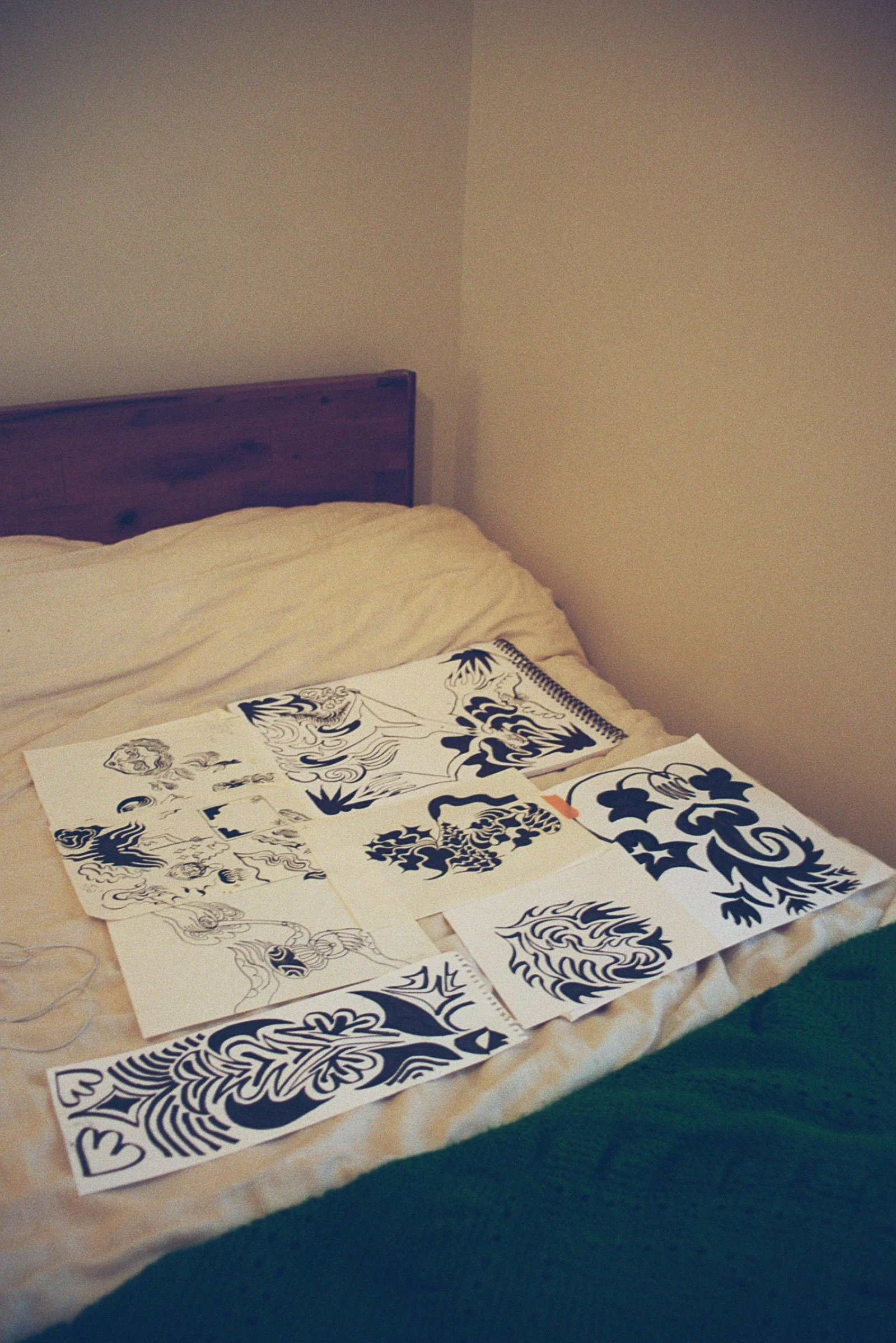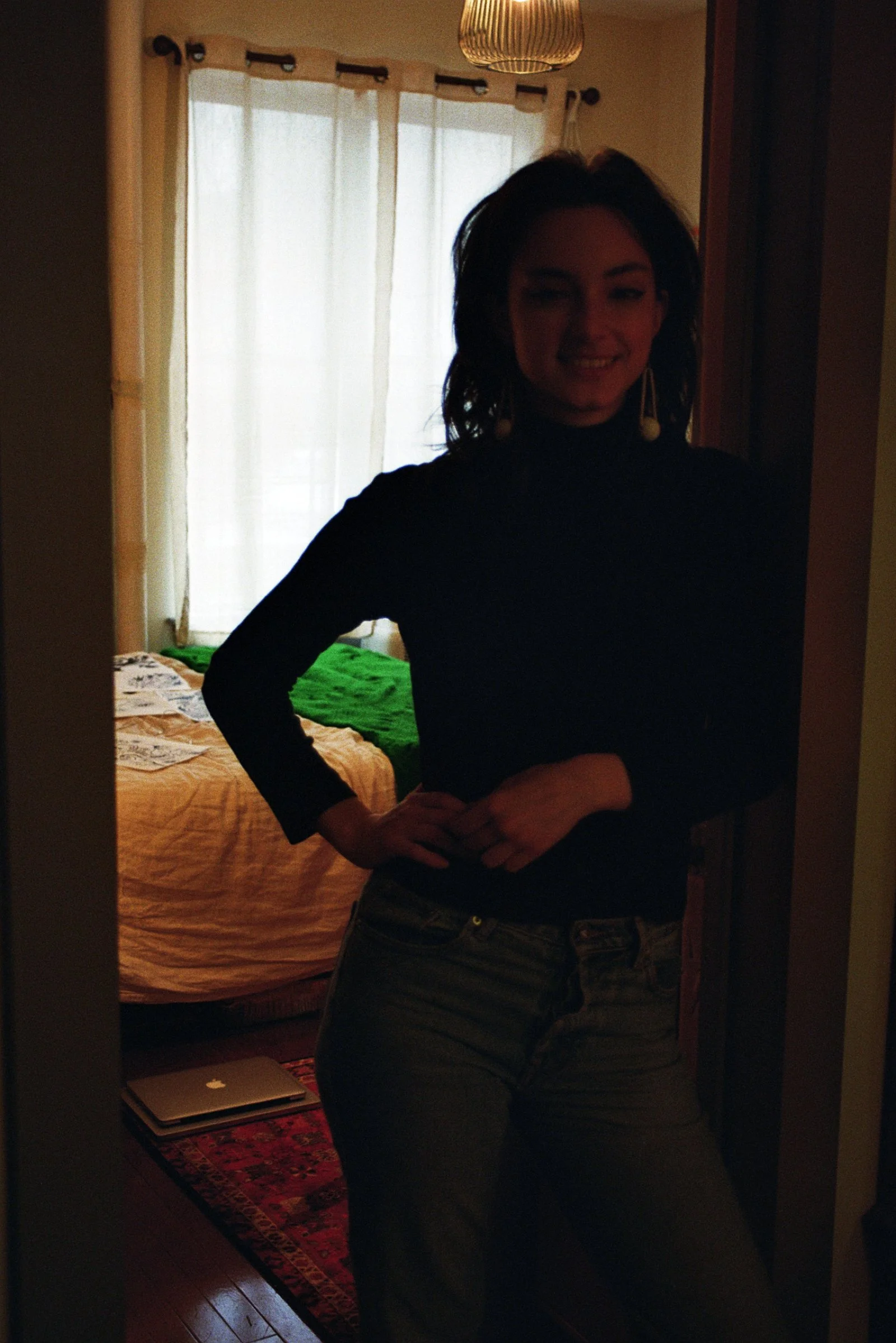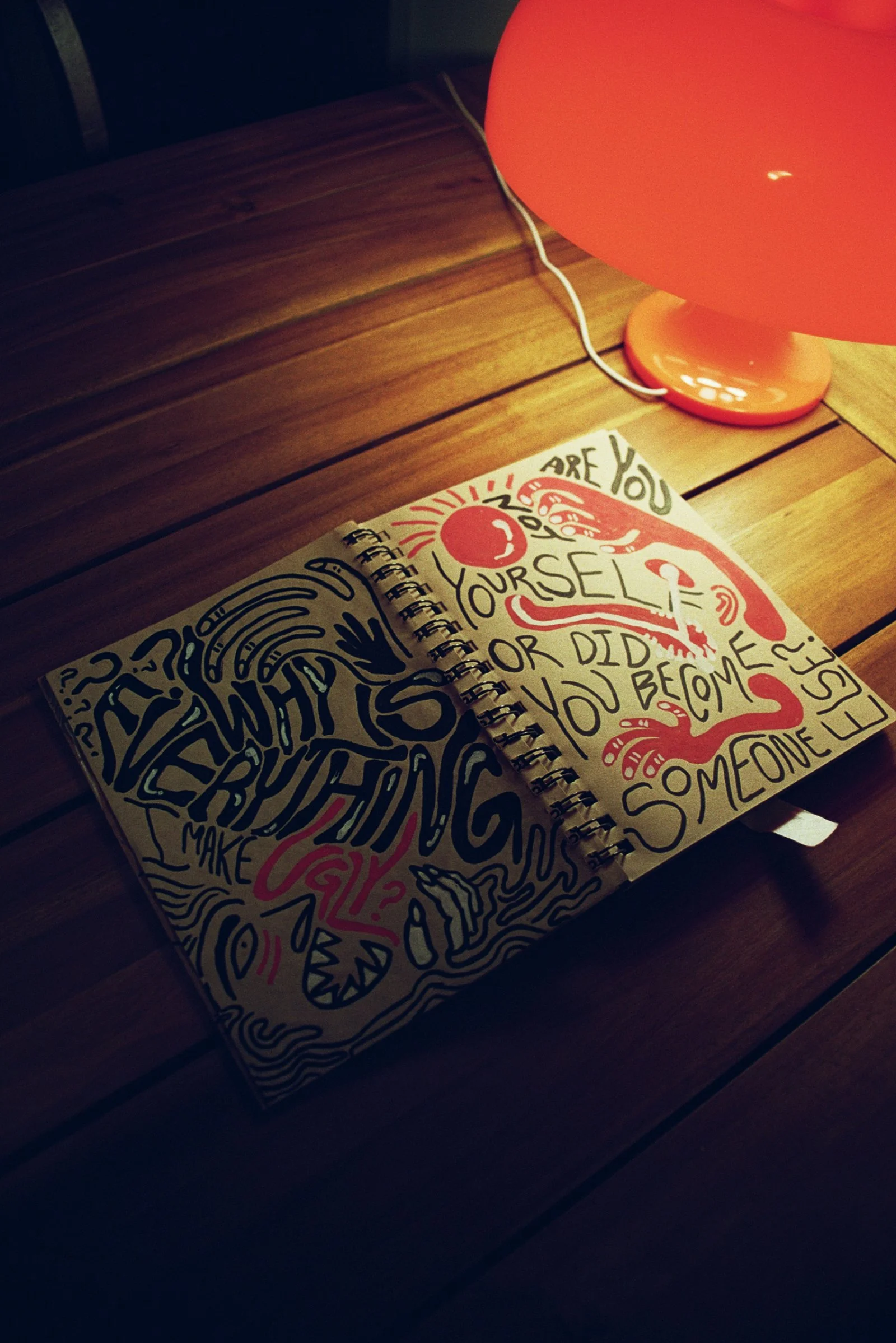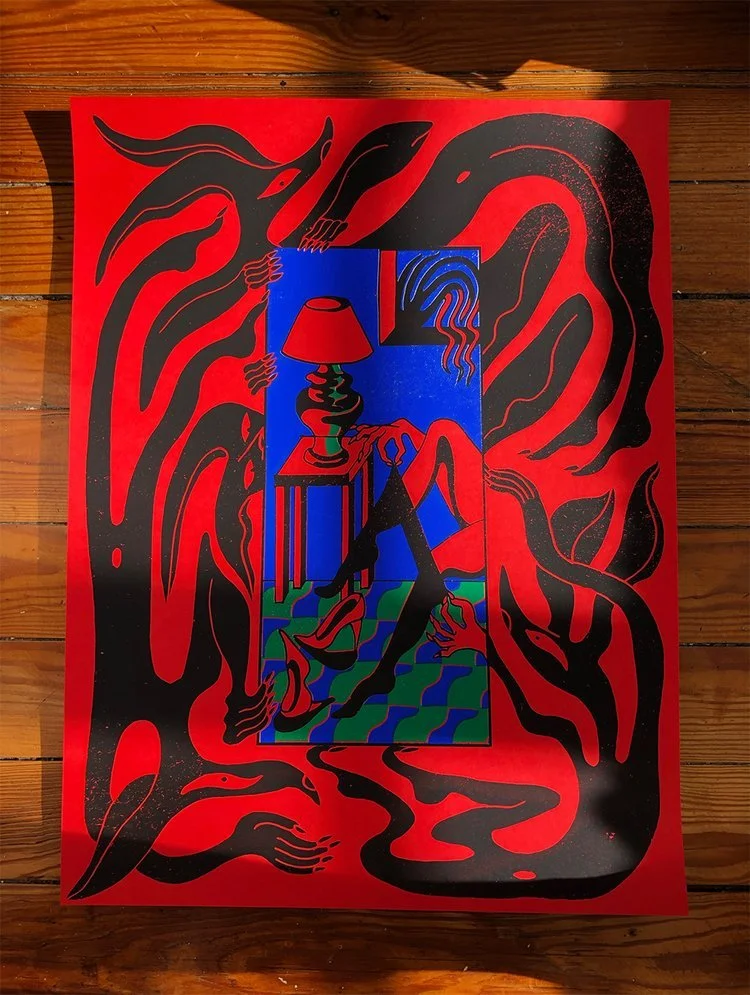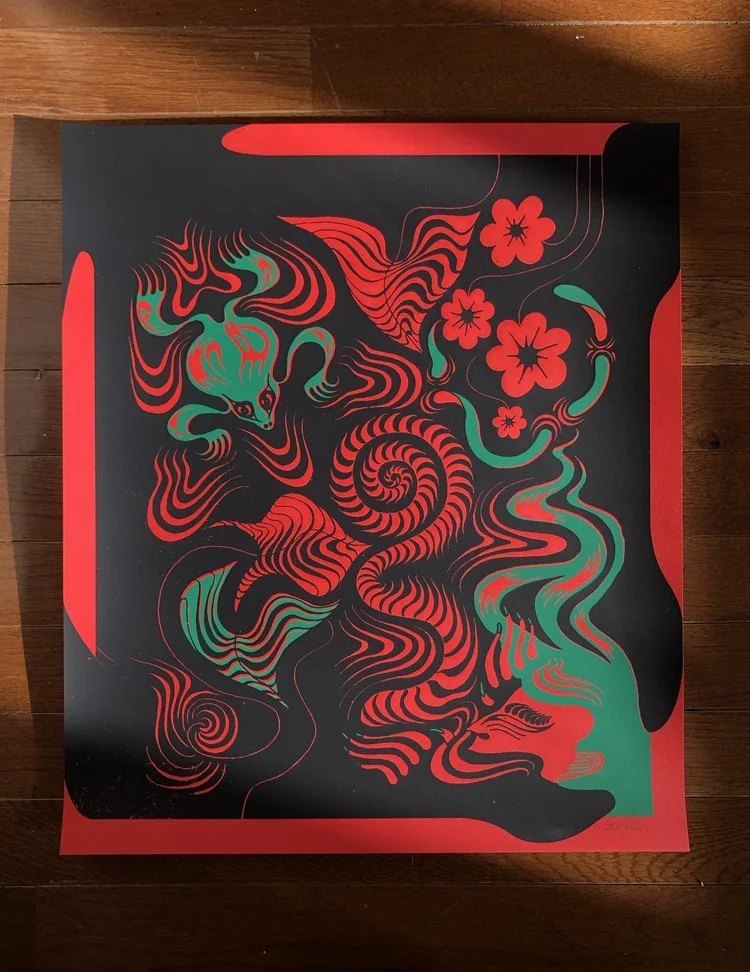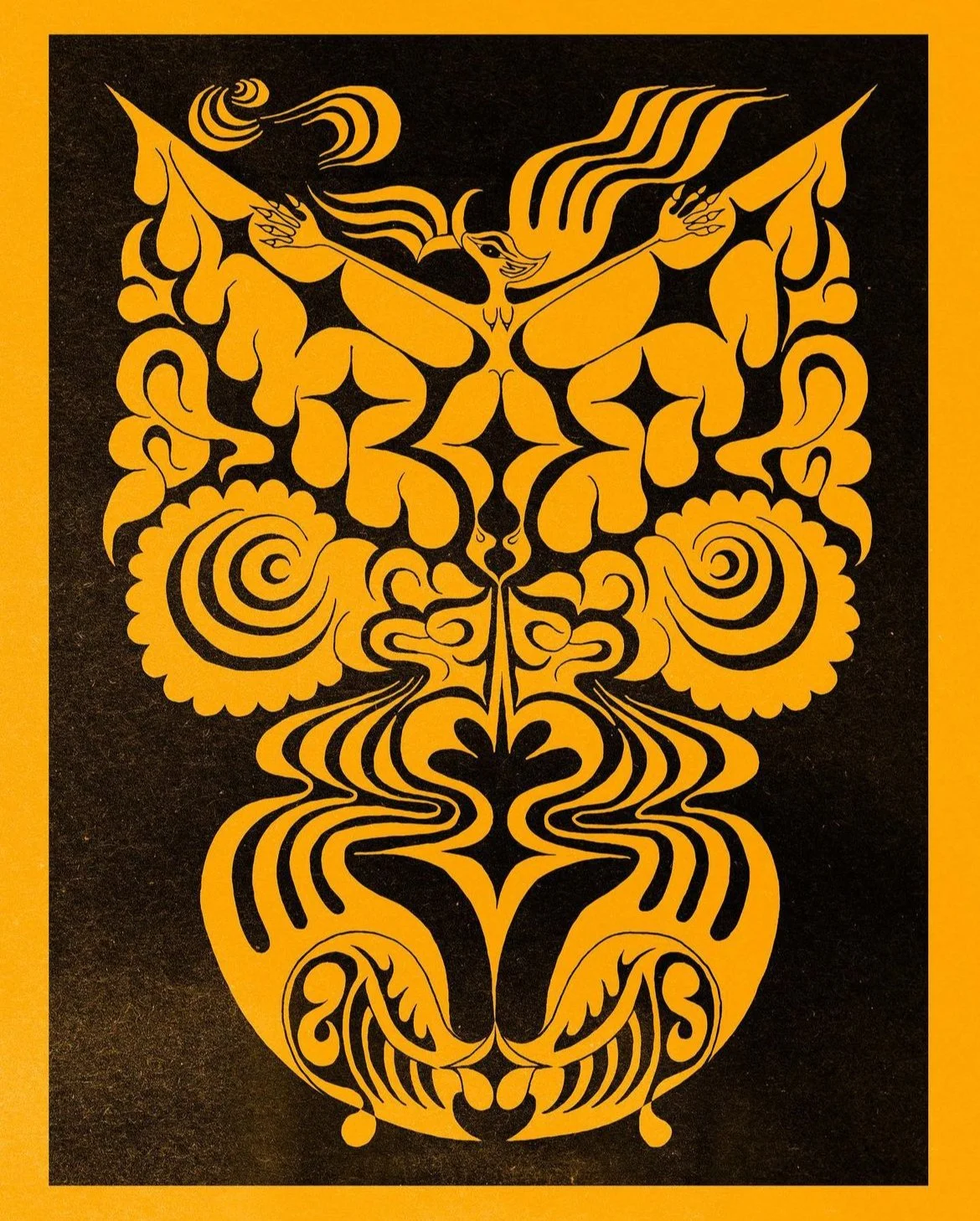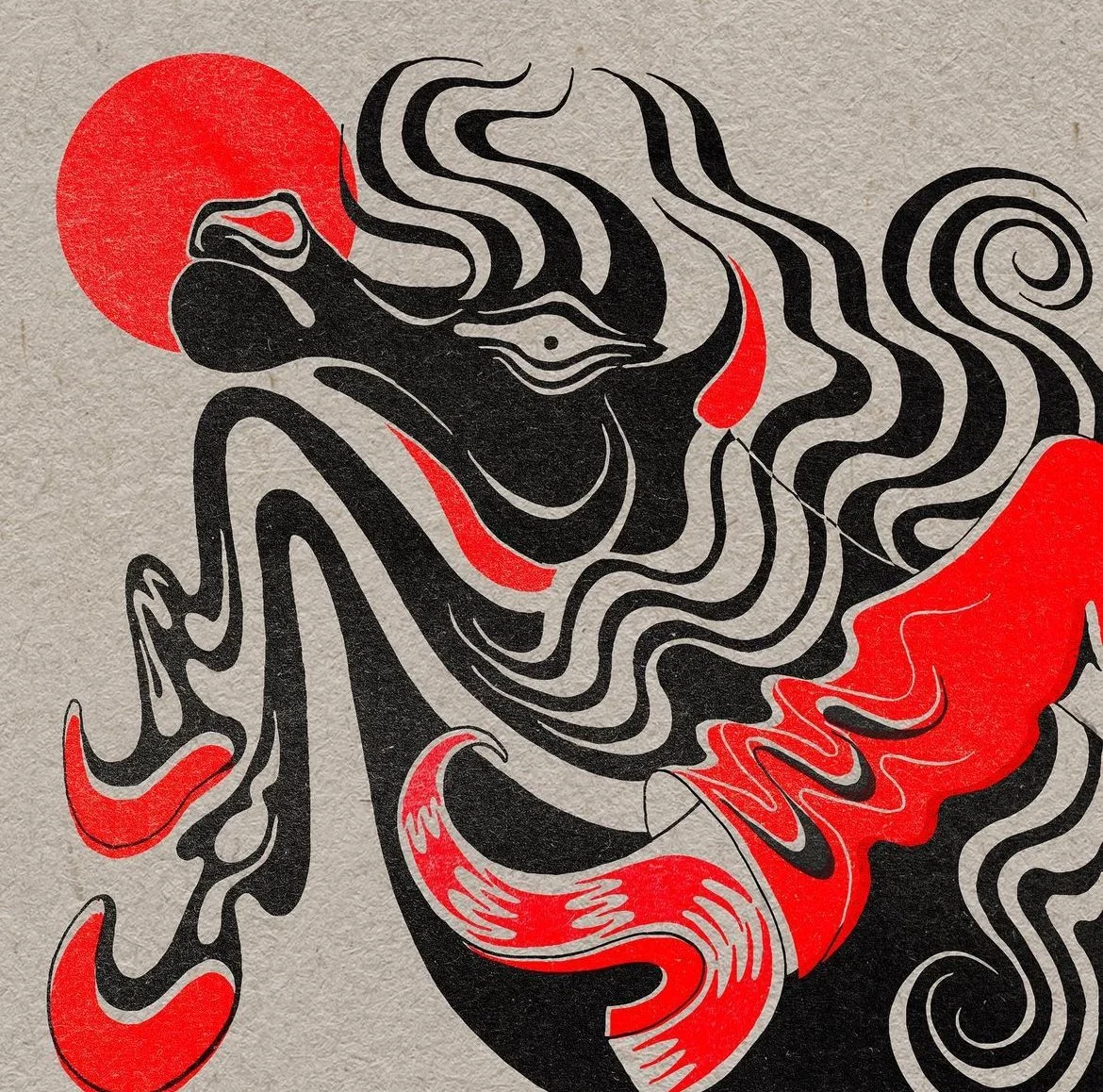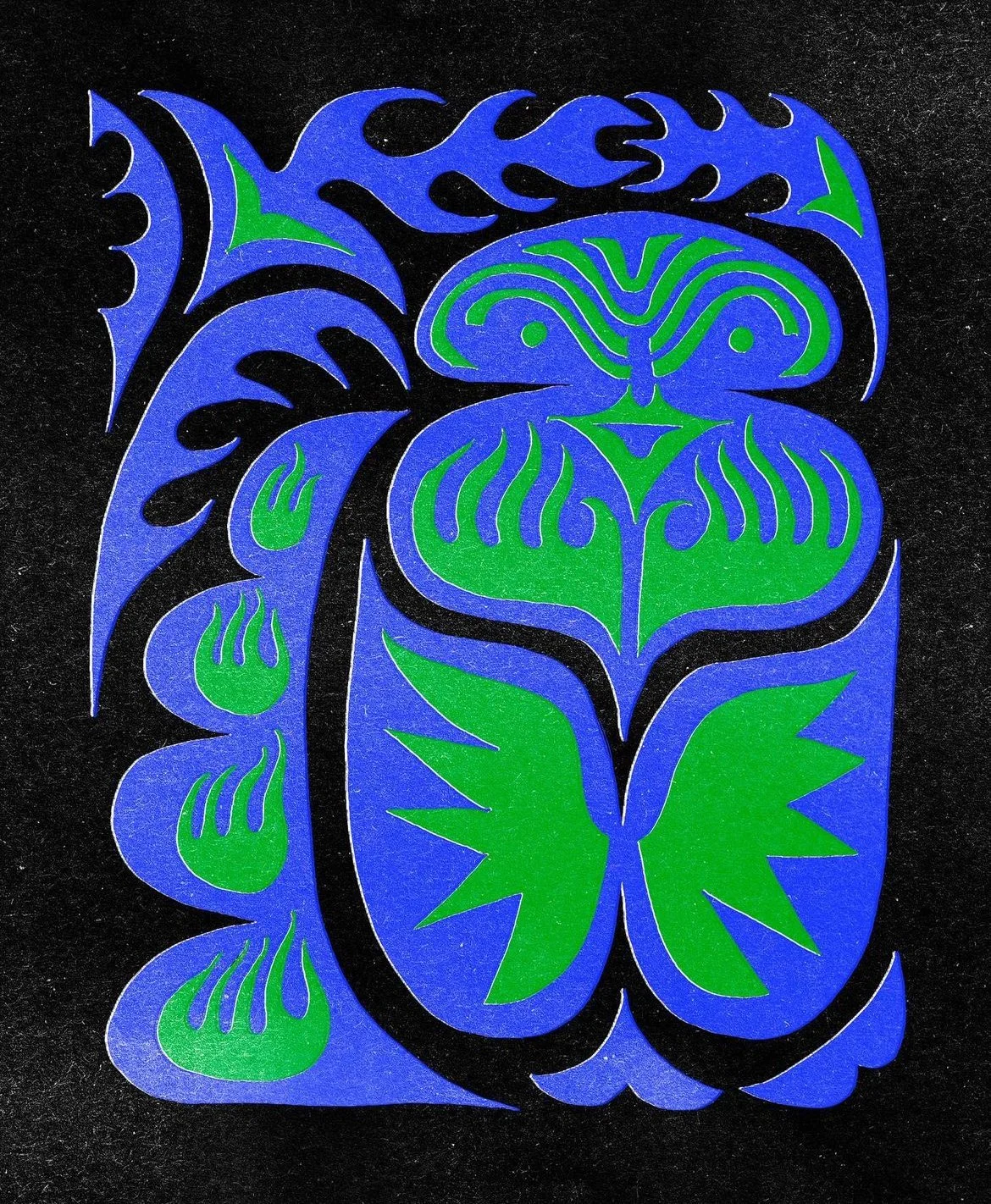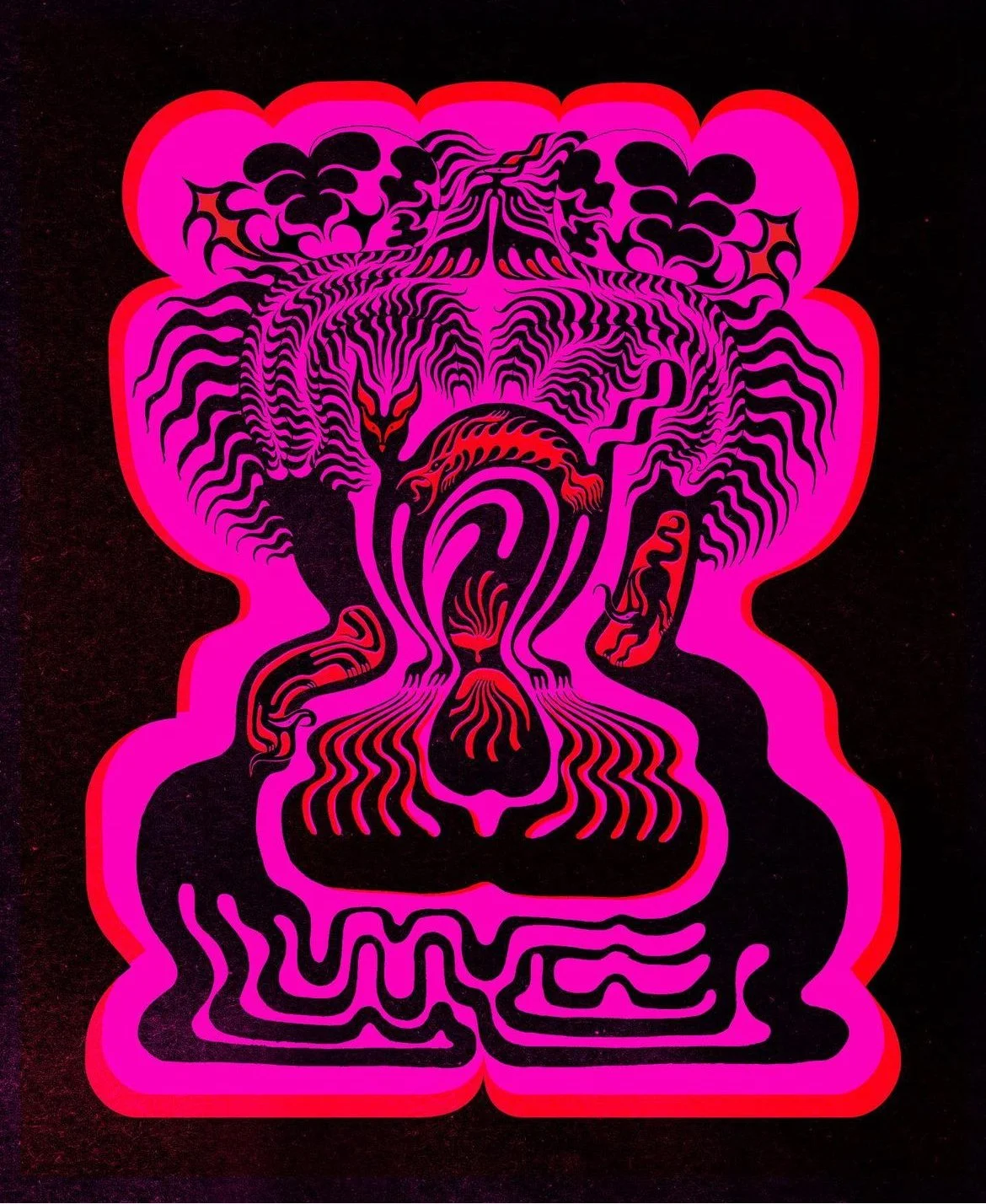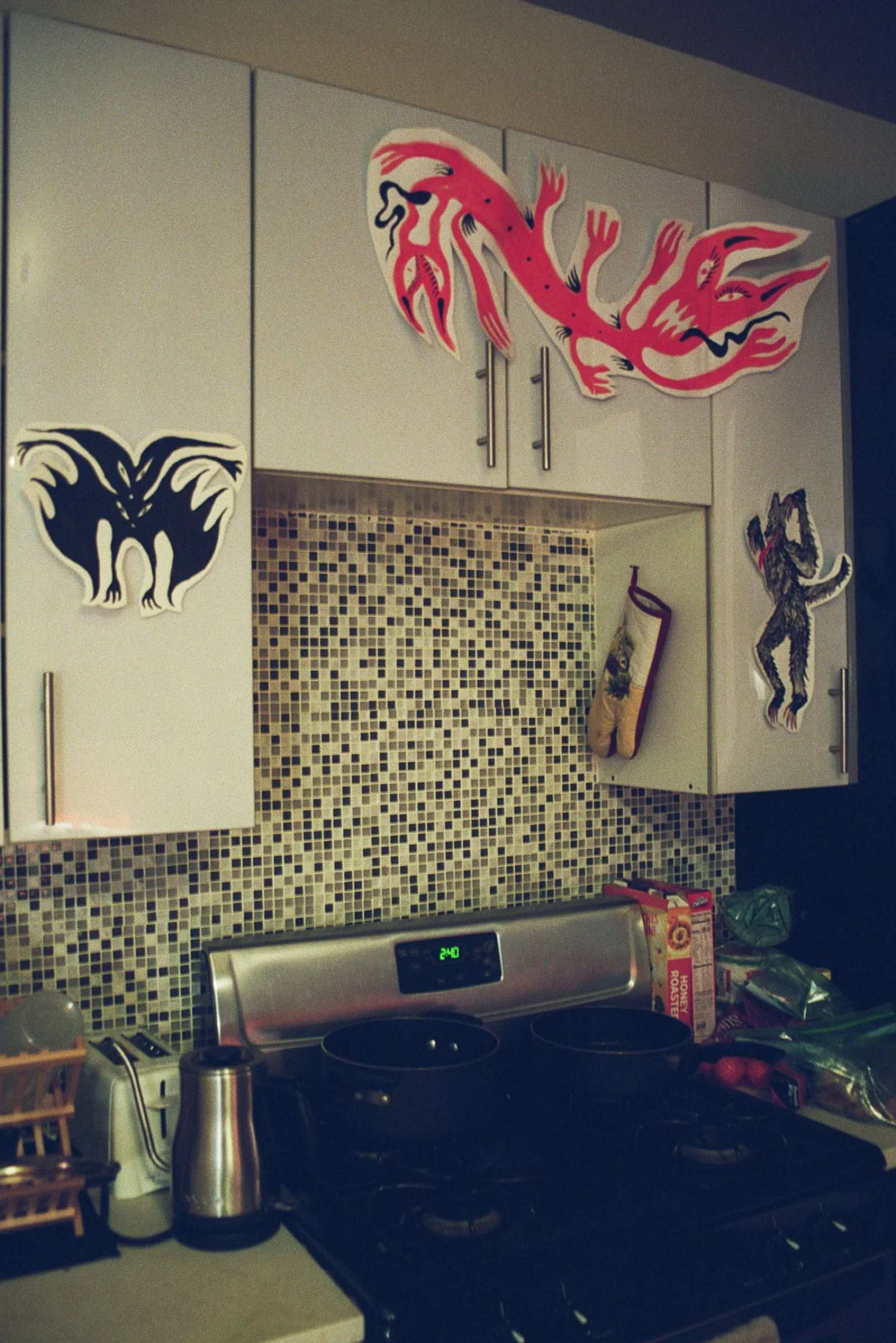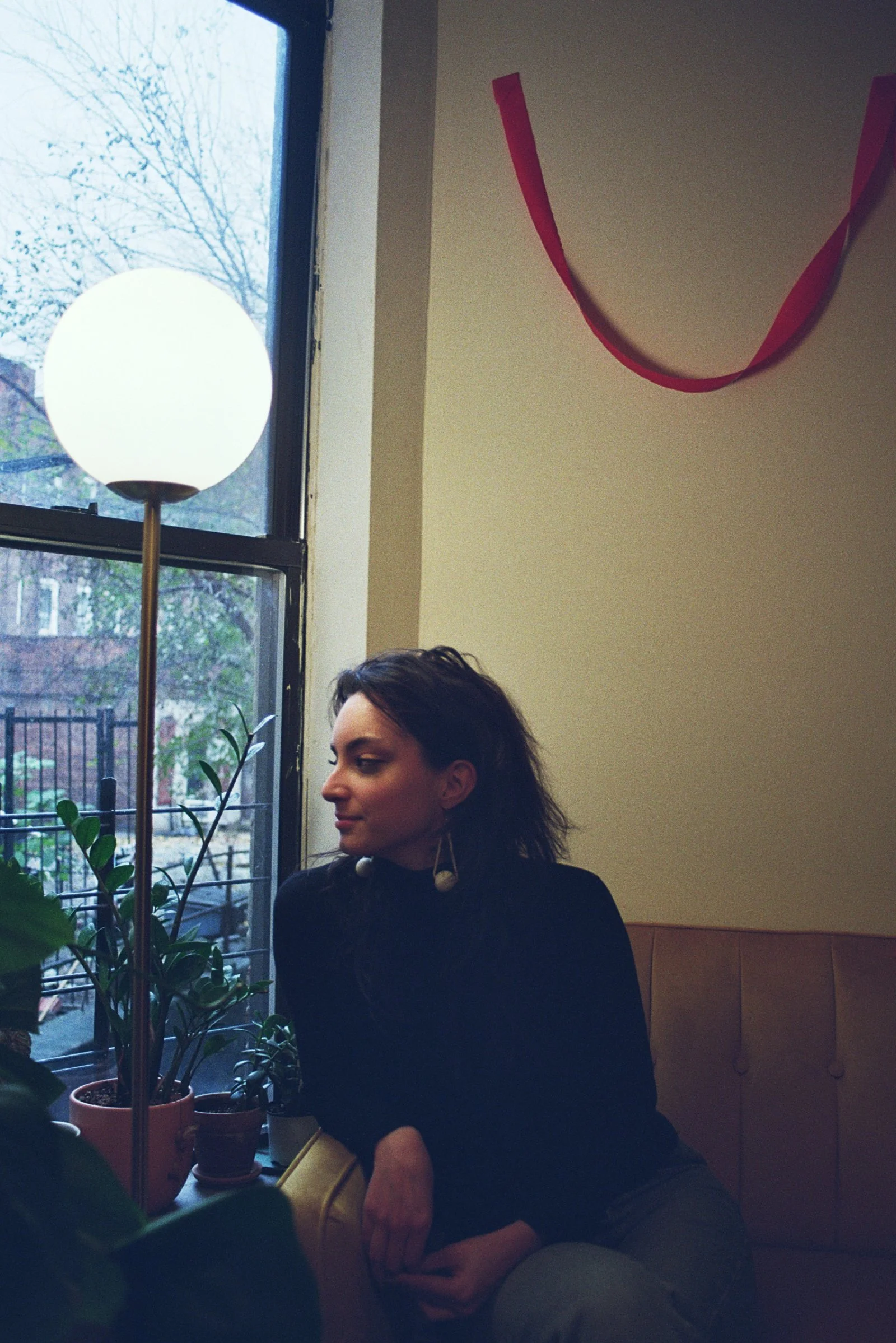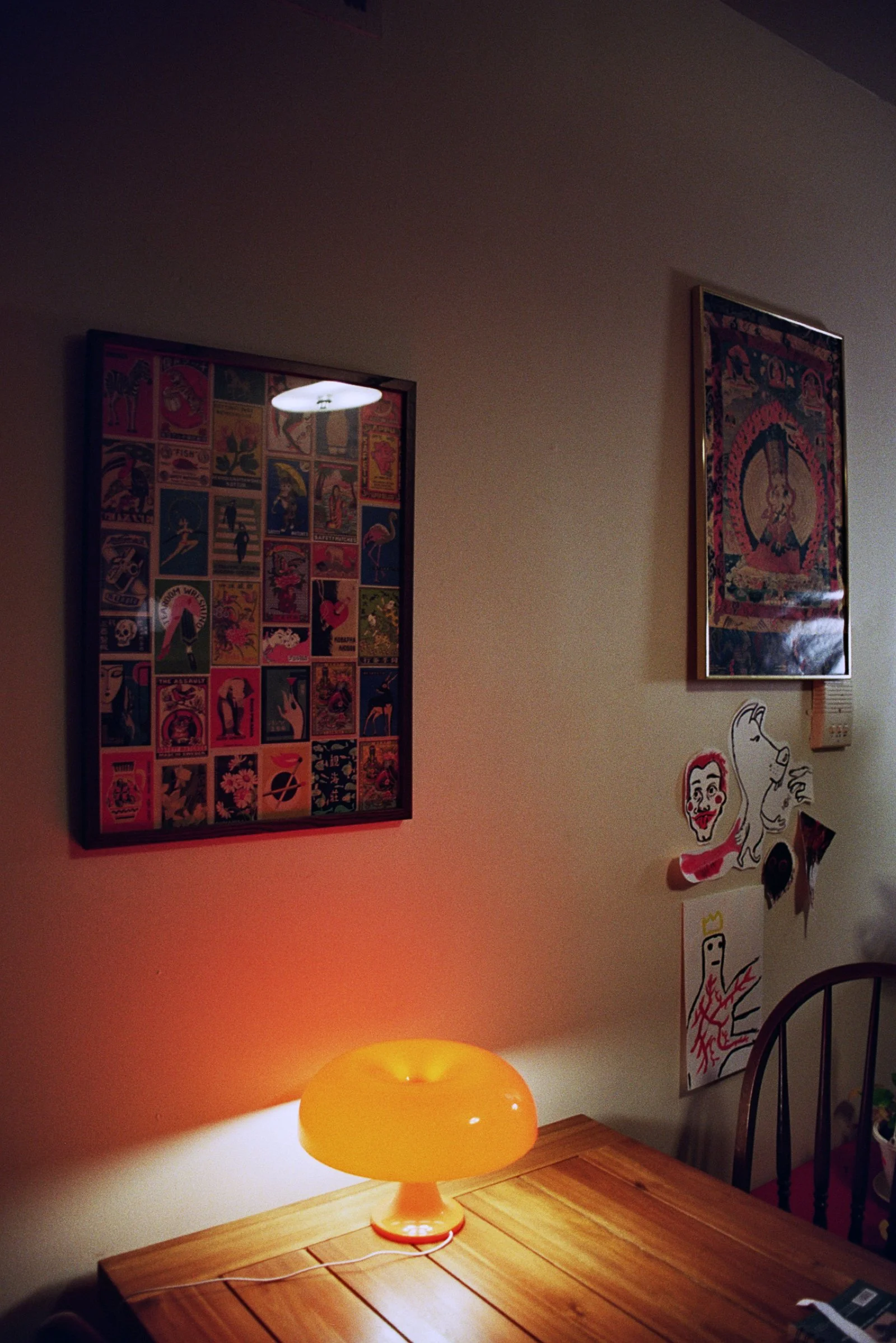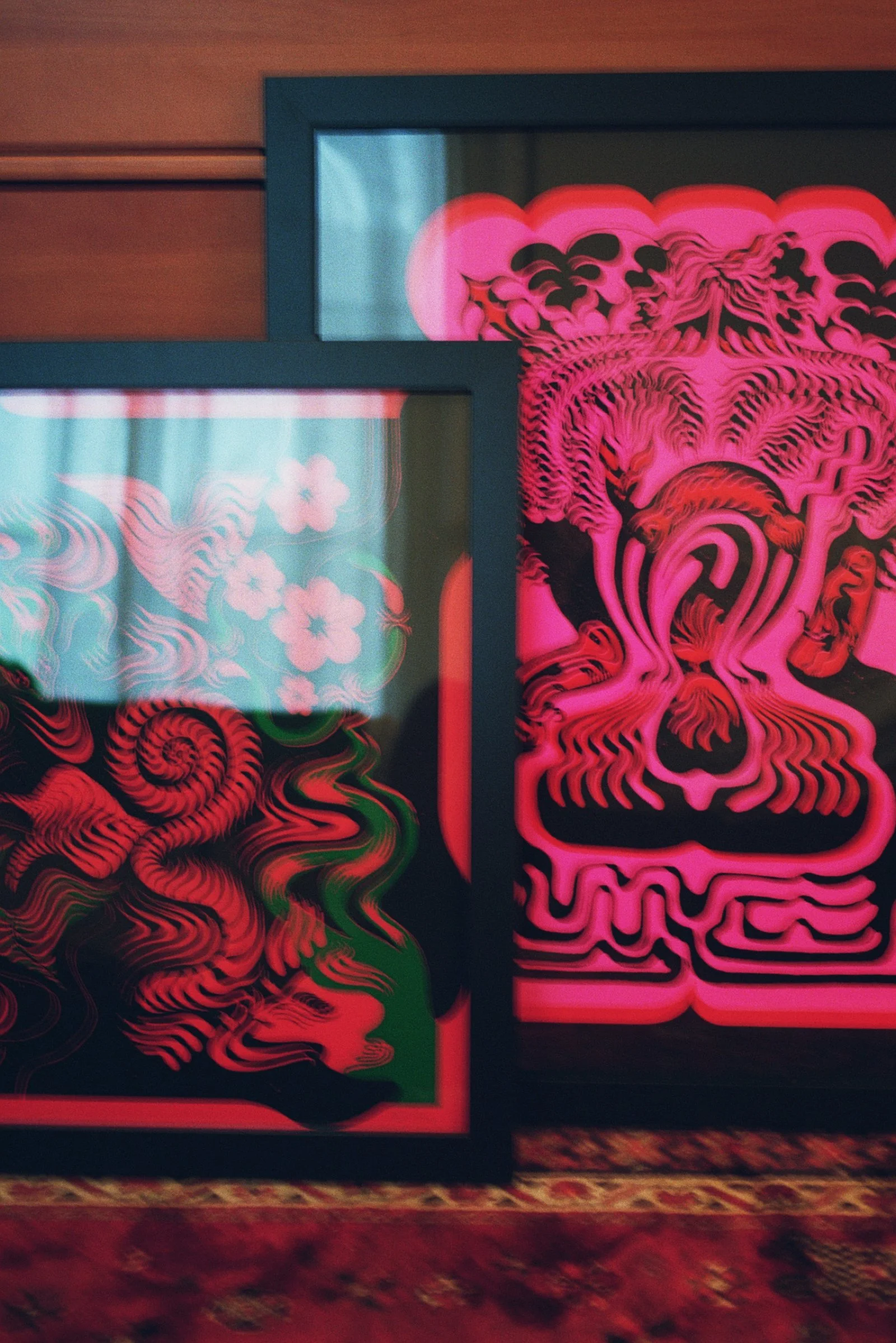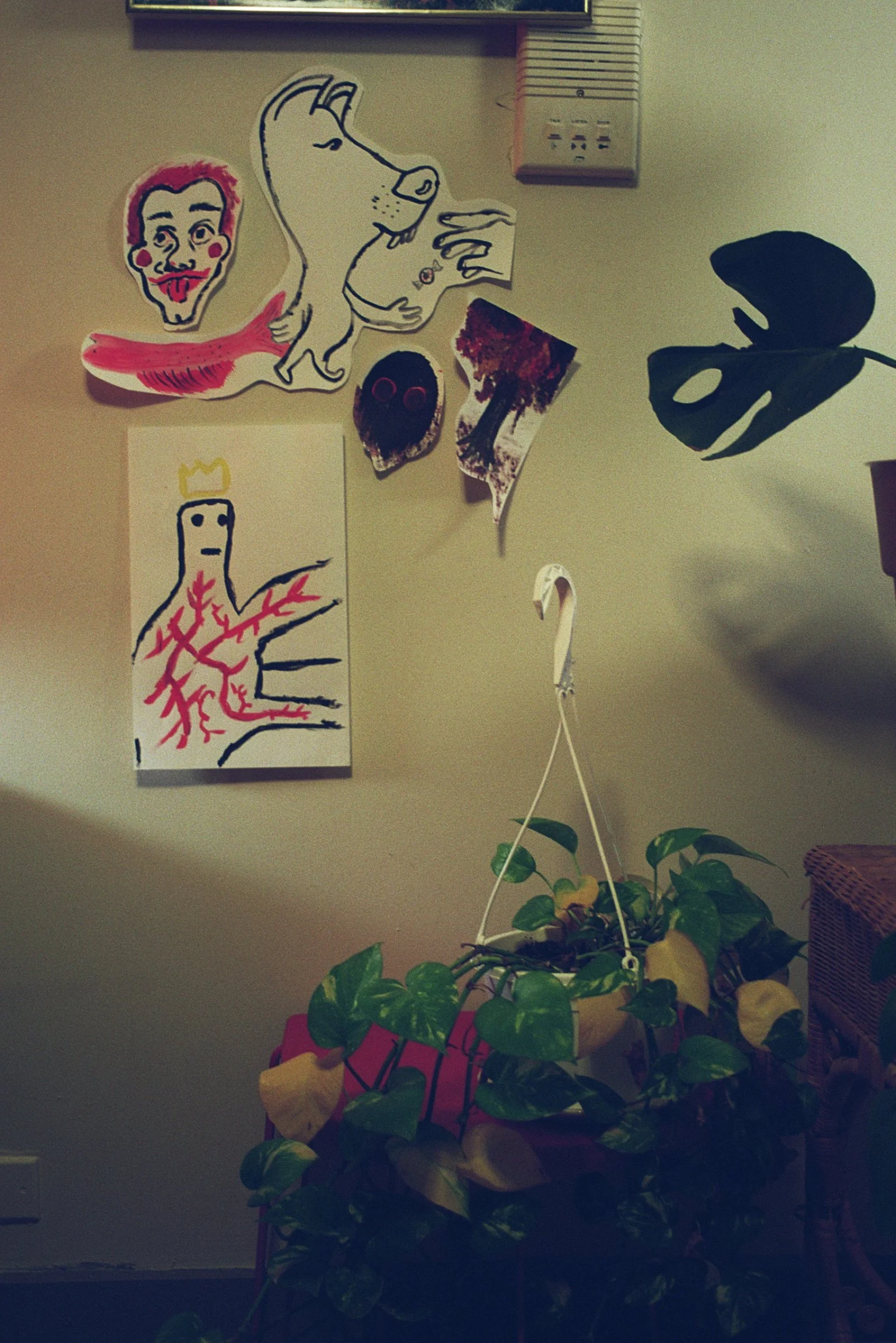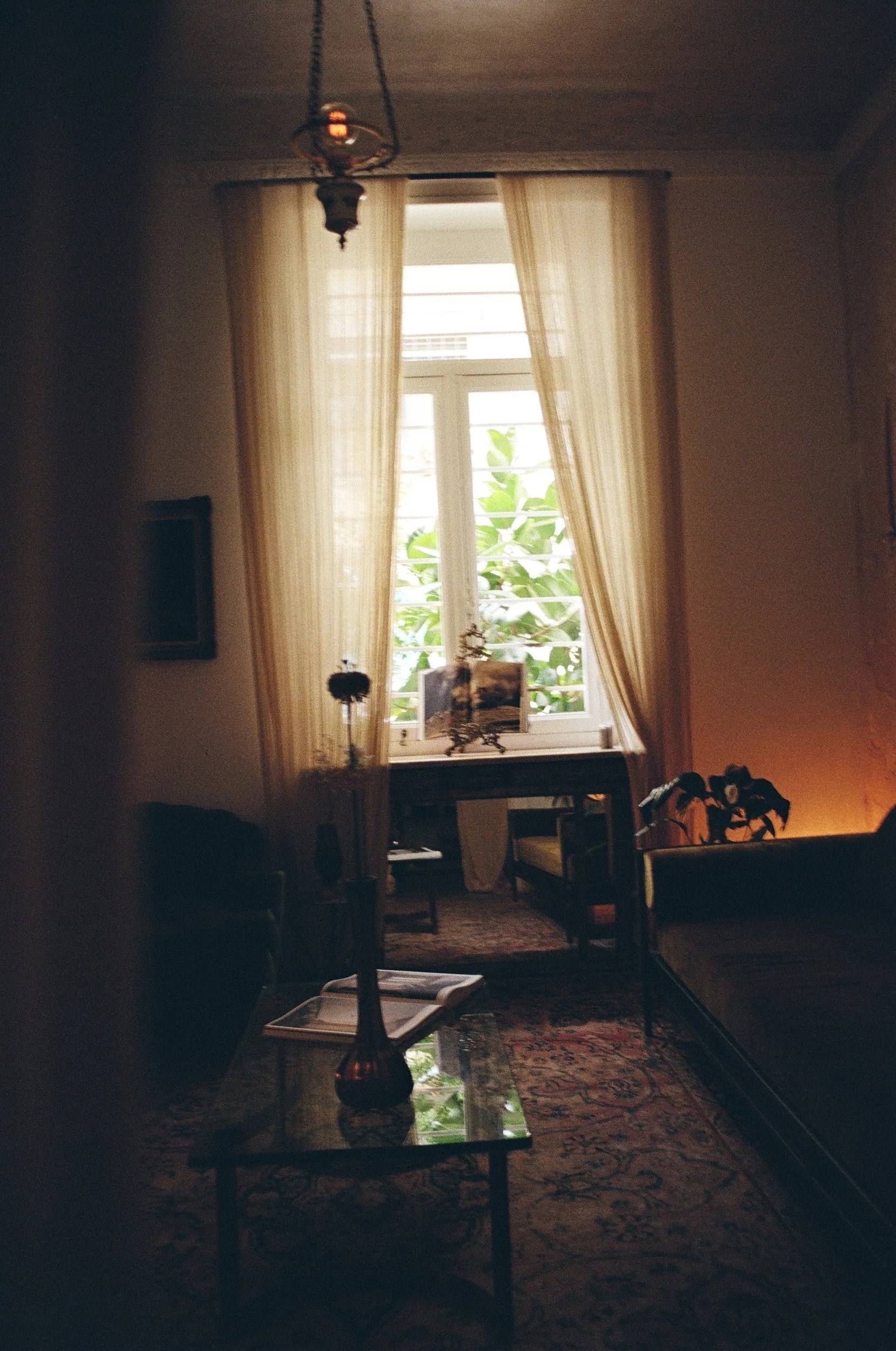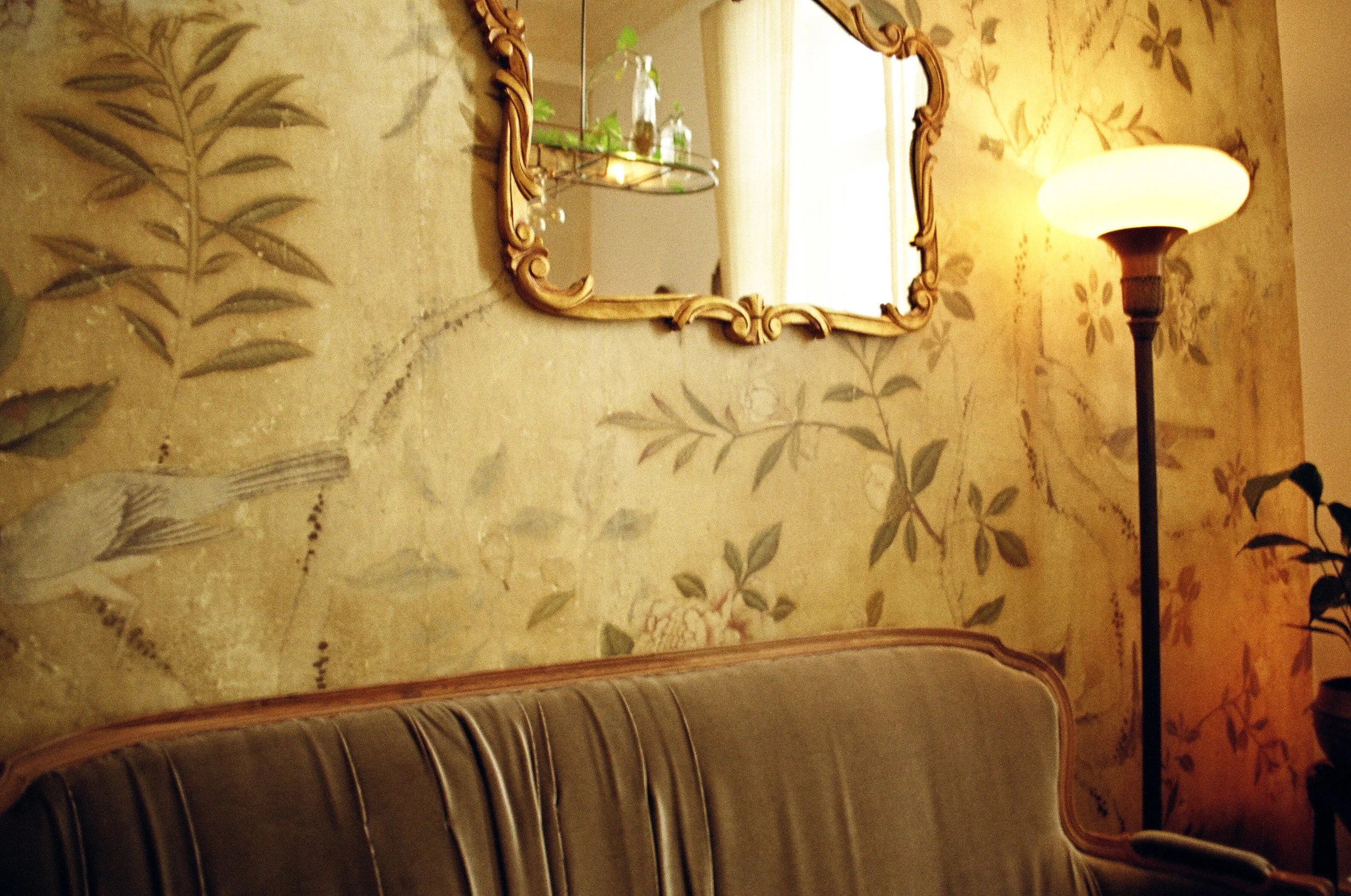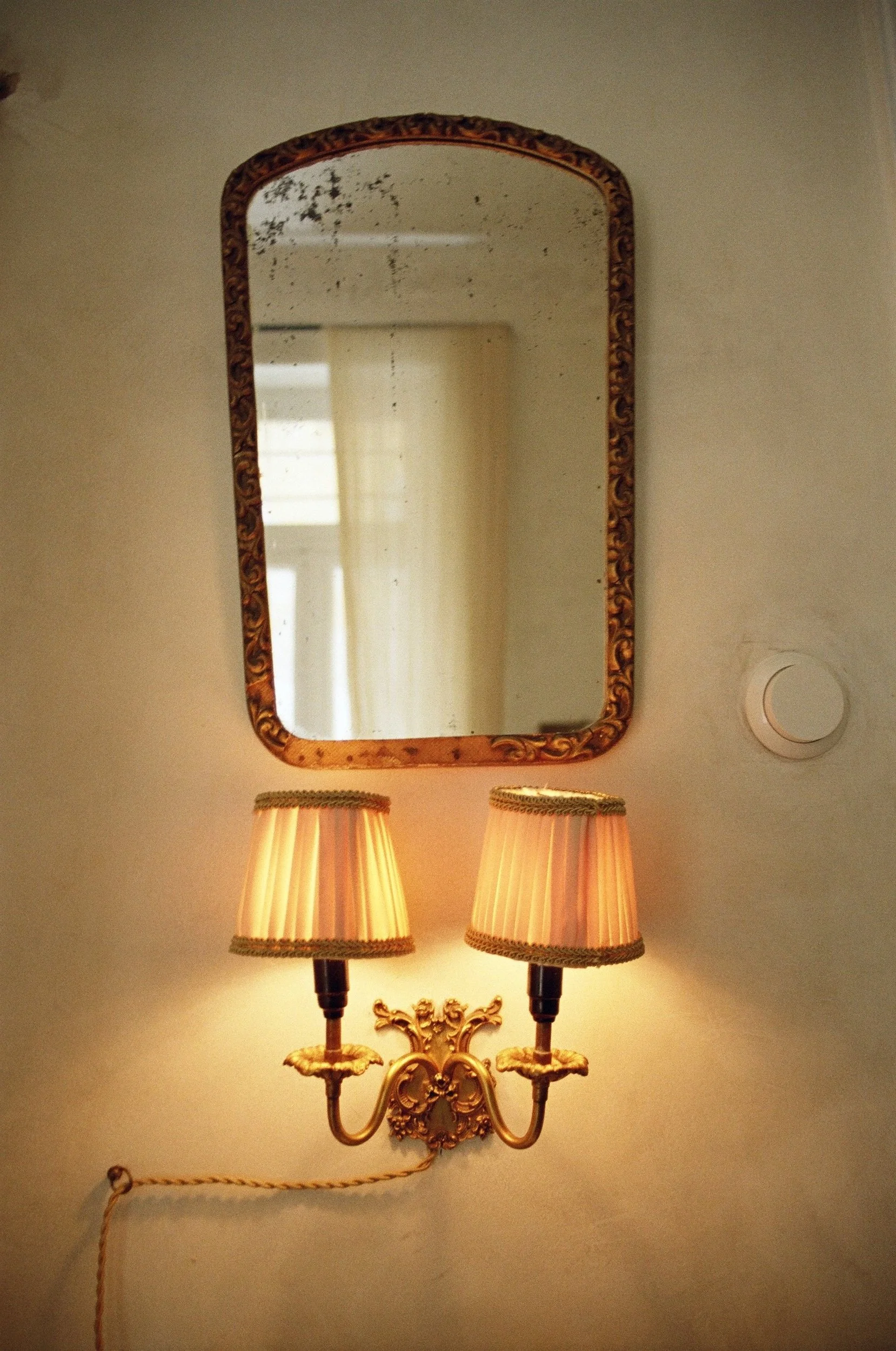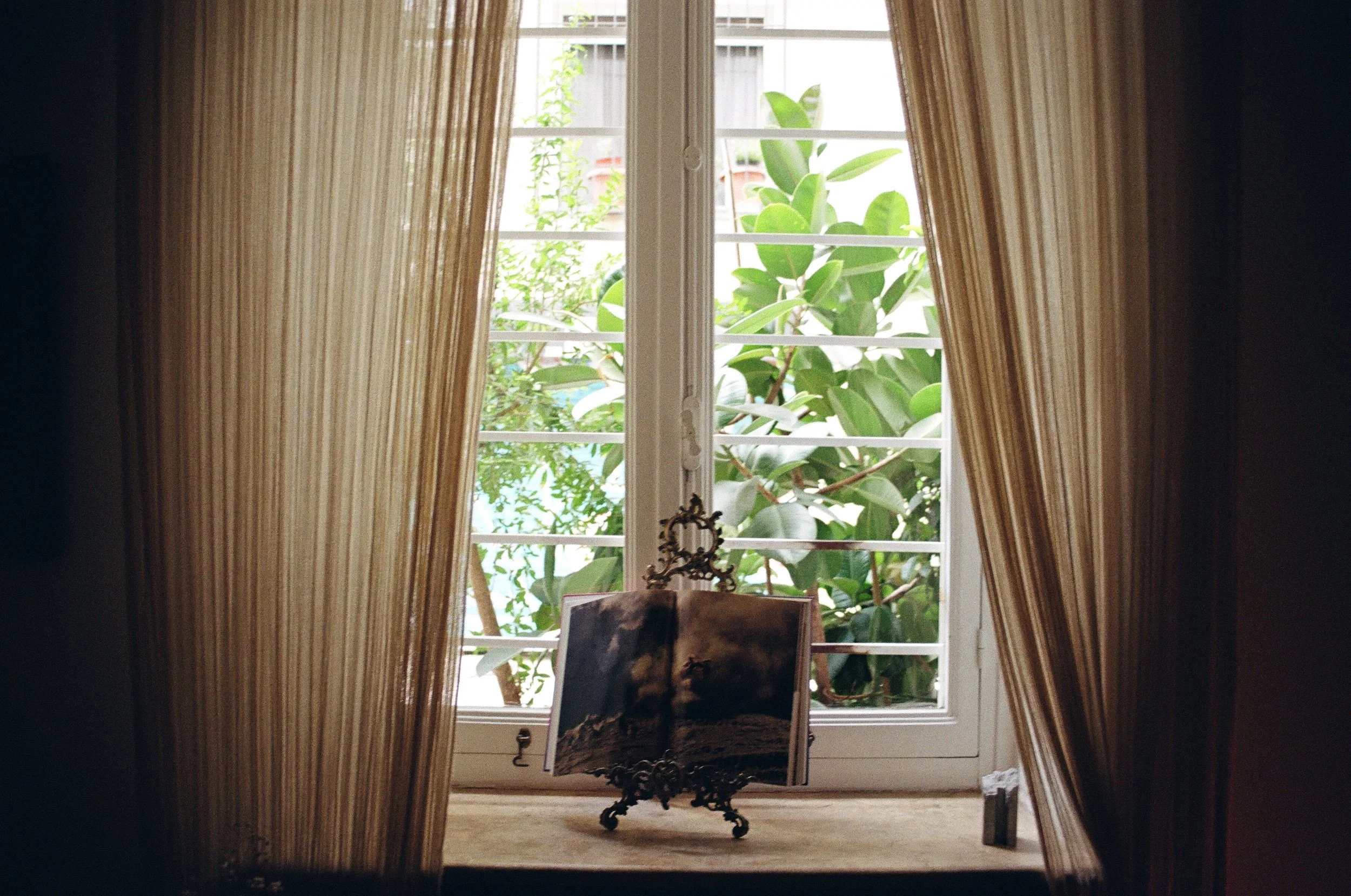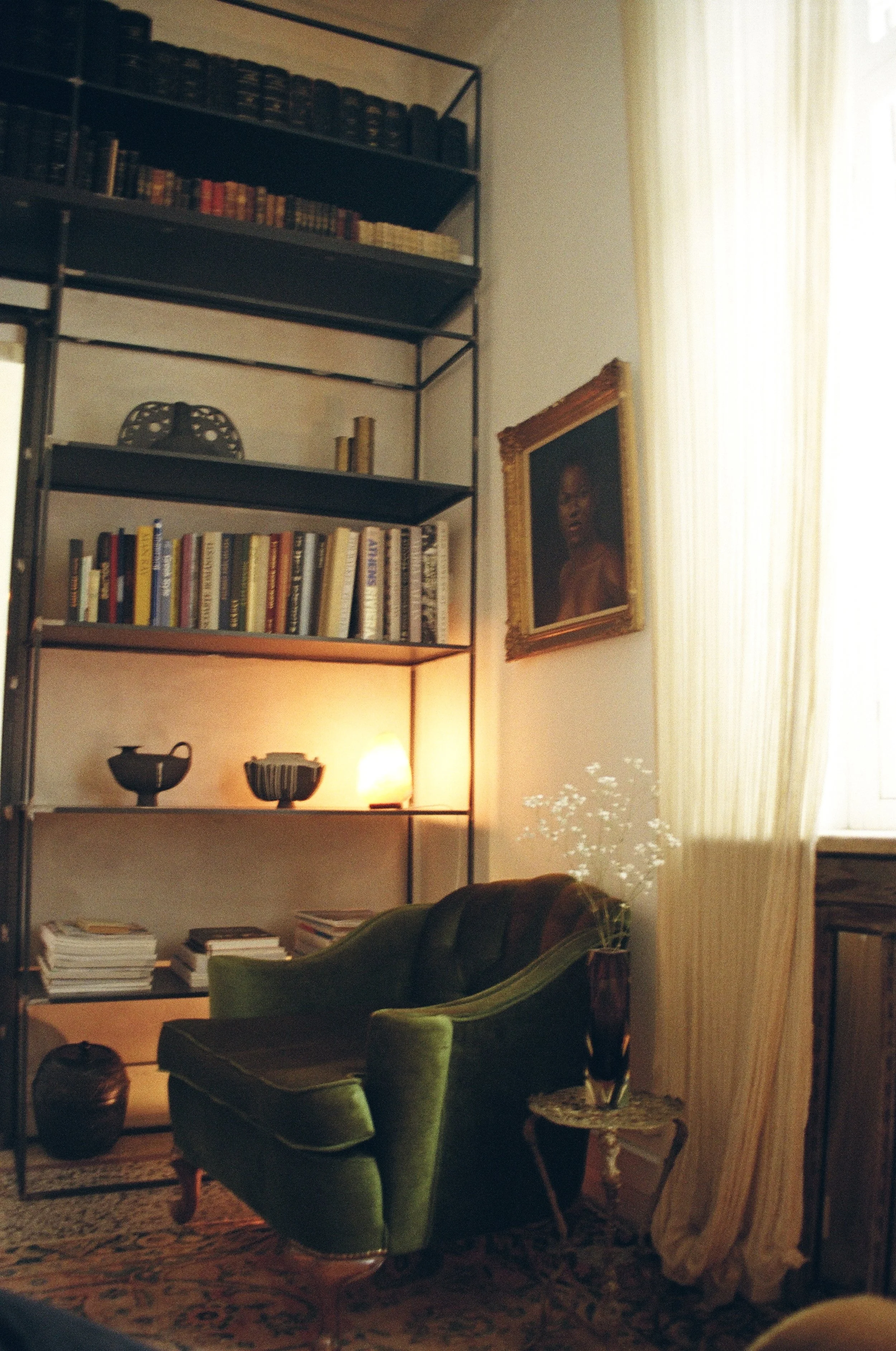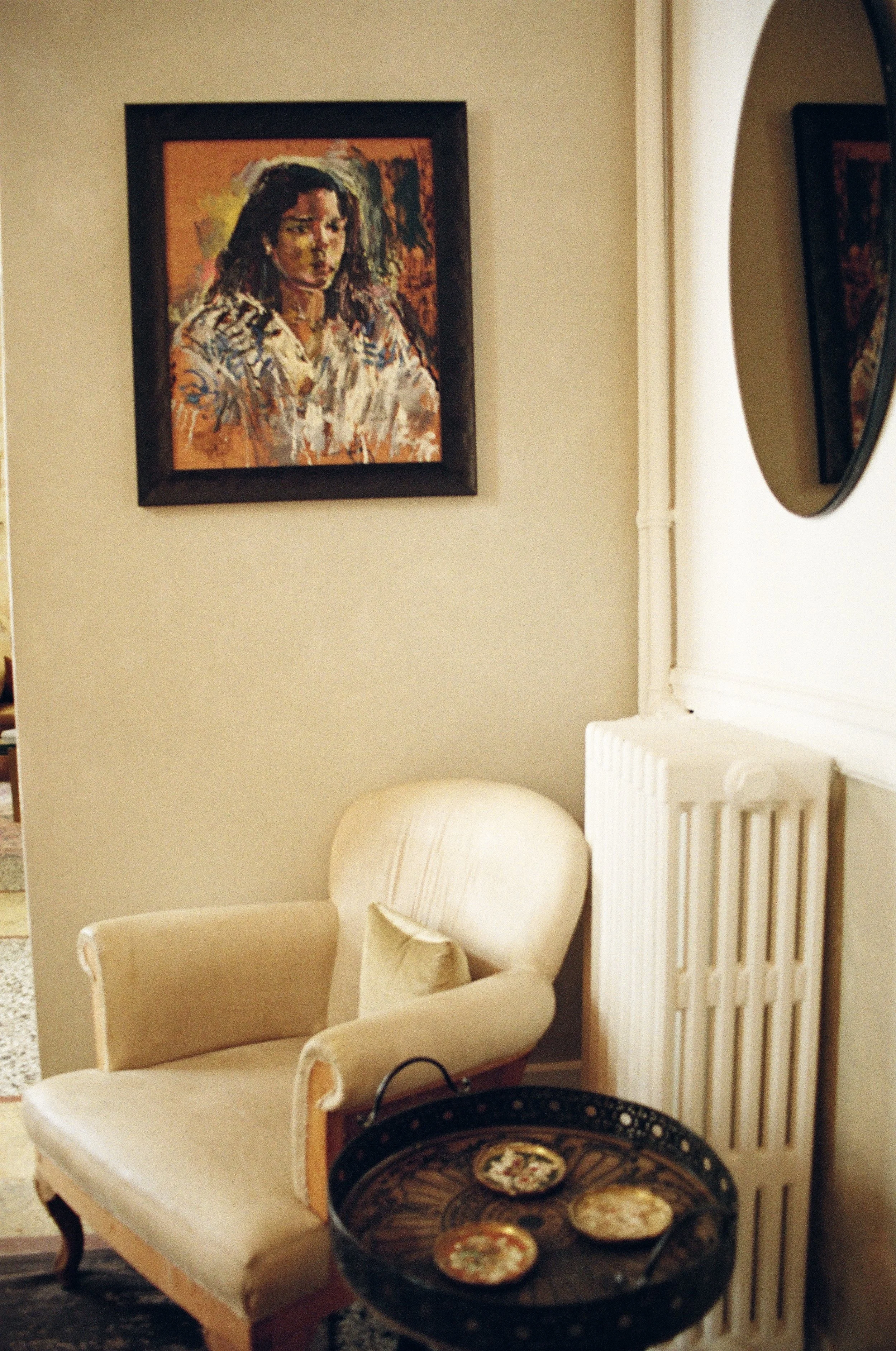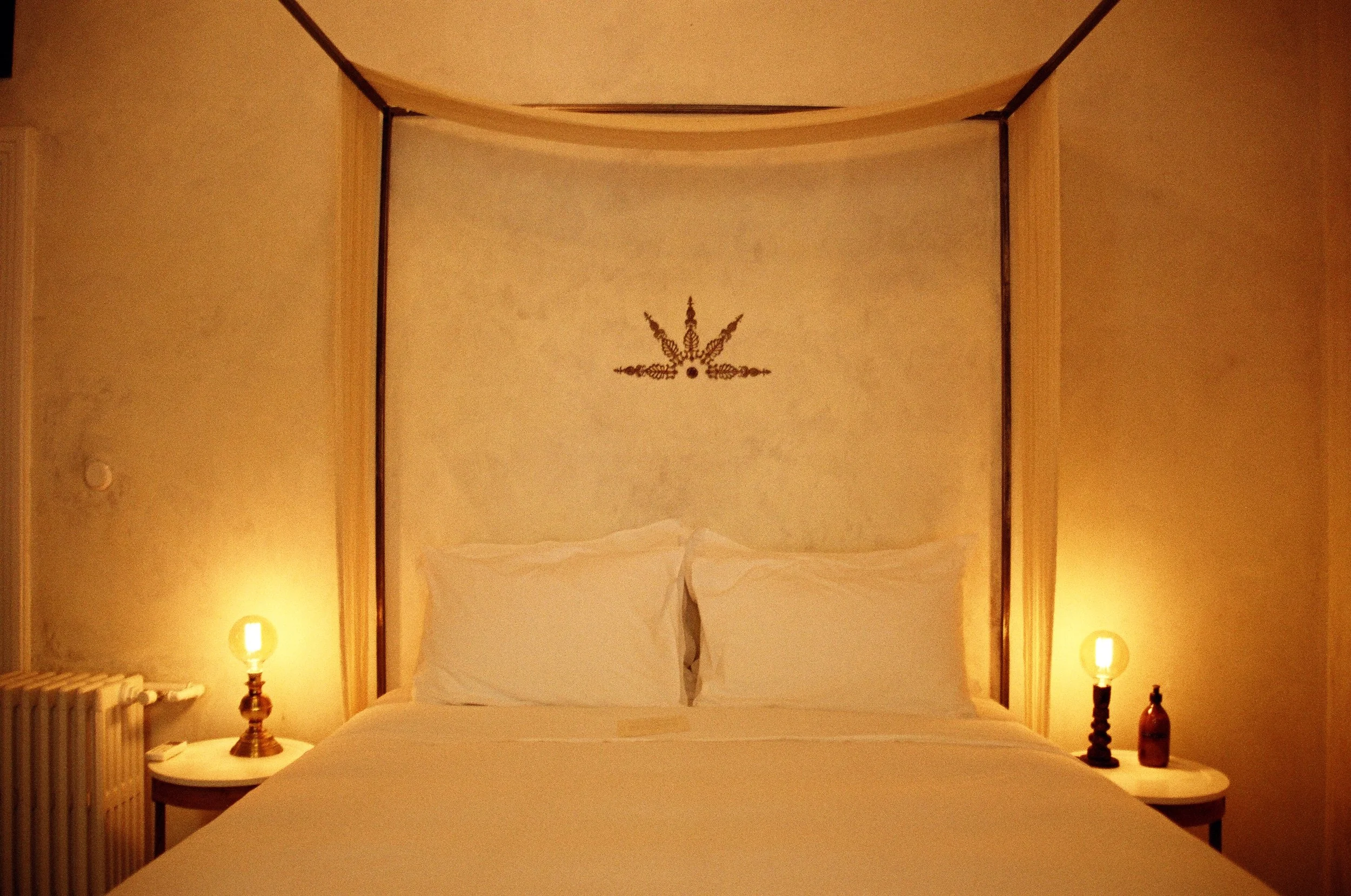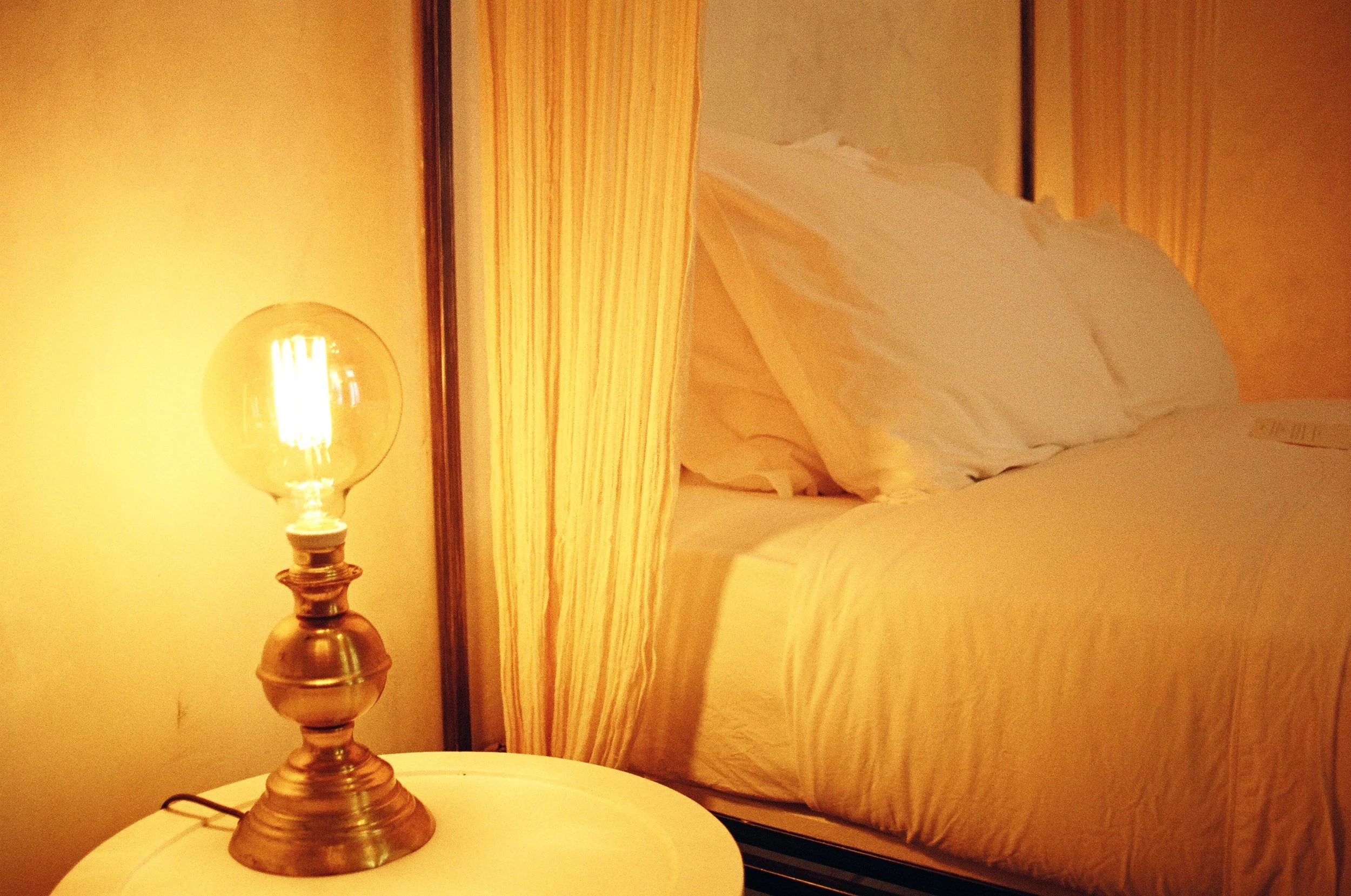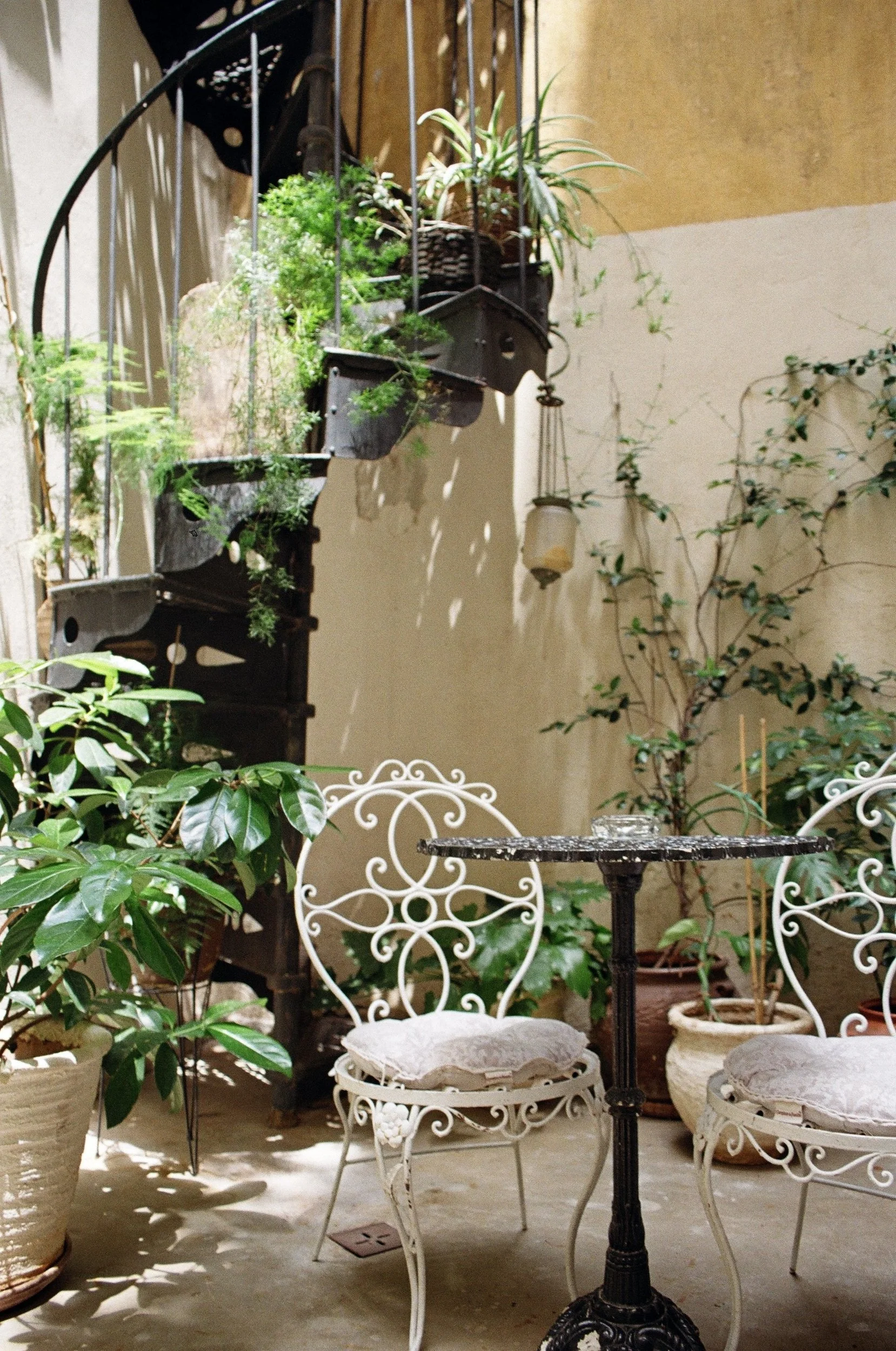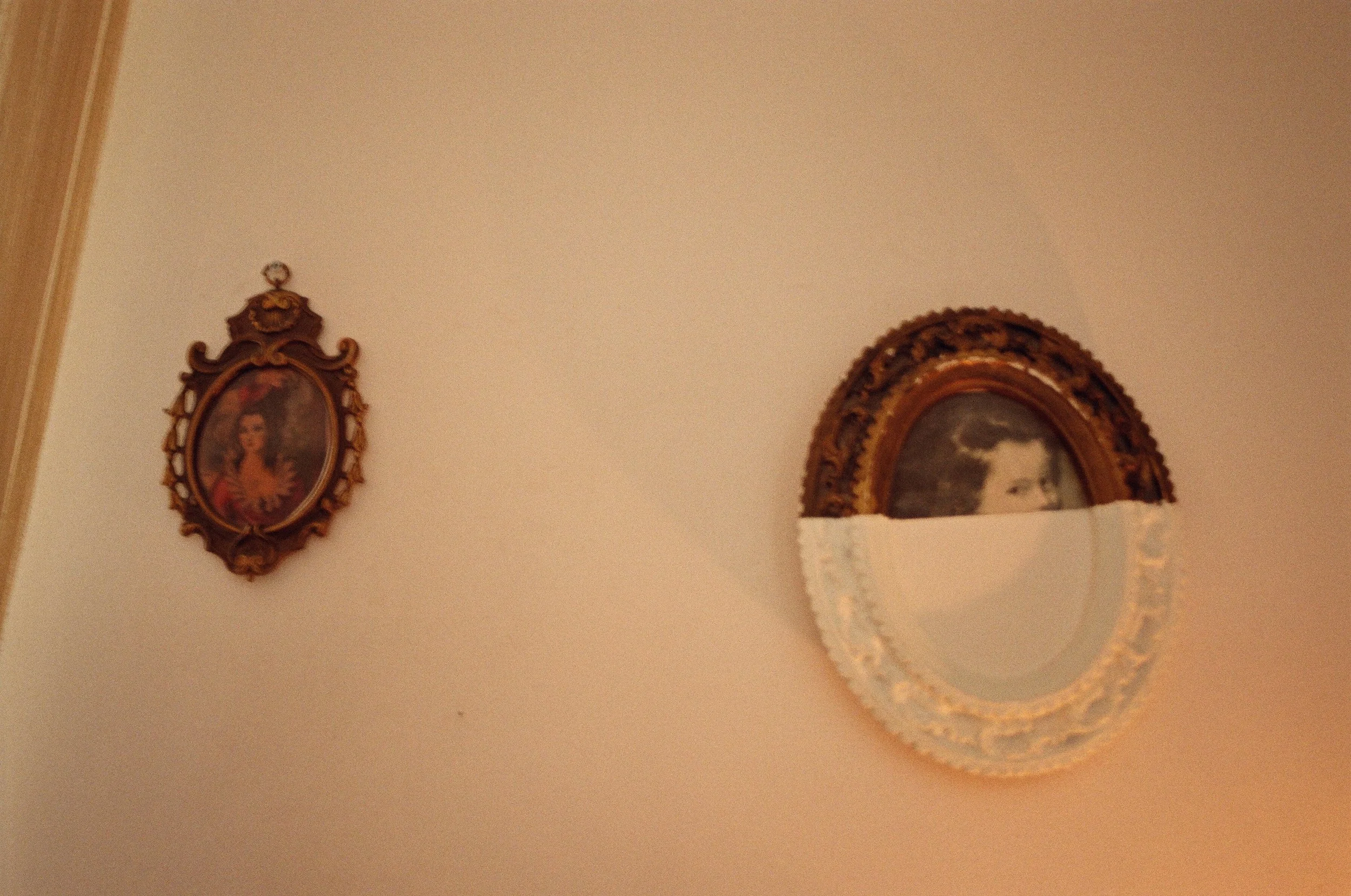in conversation with . . .
Layla Nami
Photo courtesy Layla Nami in her former home in Crowm Heights, Brooklyn
Layla Nami is an artist whose primary medium is screen printing. Her bold, psychadelic pieces draw inspiration from mythology and folklore from around the world.
Her days are split between working part-time as a graphic designer and advancing her artistic practice from her home studio in Crown Heights, Brooklyn. She has participated in the Other Art Fair Brooklyn, Renegade Craft Fair, and Bailey House’s Gala and Auction, and had her work exhibited in the Oculus at the World Trade Center as part of MvVO Ad Art Show.
Keep in touch with Layla:
Instagram
@laylawalmartbag
Website
www.laylanamiart.com
Words by: Tina Iasonidis
Photos by: Tina Iasonidis, unless otherwise noted
Interview recorded:
In your own words, who are you, and what do you do?
Oh, shit [laughs]. I am an artist. It’s weird to say that, I guess. It even took me a while to say that I was a graphic designer because I was just like, Not yet. I will be. I think at this point, I have accepted that I’m more of an artist than a graphic designer, and I’m really excited about it.
Why design?
I think my love of art and design came from my dad, who is from Iran. He’s from this town that’s really famous for handmade Persian carpets, so he had a ton of them all around the house. They had interesting color schemes―really rich reds and greens. I think the color schemes of those carpets inspired how I use color now. They’re all [full of] plant and animal motifs, with everything intertwined, kind of like a puzzle. Those are the kinds of compositions I like to make now. My dad also had a lot of masks and art from Southeast Asia and paintings from Vietnam and art from all over the world, and that really inspired me.
How did your childhood influence the way you think about and experience design?
Seeing the ways different cultures draw faces, people, and animals in stylized ways really impacted me. I didn’t consciously register that until adulthood. I think a lot of the art my parents had was creepy. Neither of them are like, “Oh, we’re into weird art,” but the art my dad brought home from places he went was a little bit spiritual, in some way, or relating to mythology. He also told me a lot of Iranian folktales growing up at bedtime. I think that impacted my ideas of art a lot because a lot of the narratives in my drawings are like fake, mythological creatures.
You’ve lived in many places growing up, including Hong Kong, Dubai, Singapore, and Tennessee. How have these different environments and cultures influenced you?
The two things I would say are how the people who live there dress, and the greenery and vegetation.
What ultimately brought you to New York?
Because I grew up in Hong Kong, I had to be somewhere where I could see a lot of different kinds of people all at once. People-watching is one of the main inspirations for me and the things that get me excited. You can say New York is the best place to do that in America.
The other reason I moved here is because of walking. That’s a huge creative fuel for me. I feel like having to walk somewhere and be alone with your thoughts and not do anything or sit on the train not doing anything is so creatively inspiring. I think that’s why New York is such a creative hub and people move here. It’s both so stimulating and also so mundane and boring in some ways that it’s the perfect combination.
I’m so glad I moved to Crown Heights. It’s so visually inspiring. The wrought-iron gates, the metal fixtures on buildings . . . almost Art Nouveau in some places. I love taking pictures of doors and different facades on buildings. Just walking around here is enough inspiration for a drawing.
How did you launch this career? Did your studies lead you here?
I was only doing graphic design up until the pandemic and then quit my job right before because it was just so stressful. That’s when me and my roommate both deep down wanted to do our own thing and be artists. During the pandemic I was like, Well, I don’t have anything else to do. I’m gonna just draw every idea that I have.
In the past the thing that stopped me from being prolific or getting anywhere artistically was I would have part of an idea and then I would be like, That’s stupid. And it’s not going to work. Me and my roommate started to video chat and do critiques every week. When I look back at that stuff, obviously it sucks, but my ideas were there. The critiques were what got me to where I feel like I am today, which is not all the way where I want to be, but I’m really proud of where I’ve gotten. I think everybody has art in them, they just have to have time, boredom, and space to cultivate it.
I definitely think studying graphic design led me where I am. When I was doing critiques with my roommate, we would always talk about concrete things to make the artworks better. A lot of the reason things didn’t look the way I wanted them to yet was because spacing between different elements didn’t feel right or wasn’t consistent: compositional things like hierarchy and contrast. I’ll do a drawing and then notice what’s not making it as impactful as I want it to be. Every drawing I do I’ll redraw, then refine it on my light box. The only way I know what I want to change is because I have a background in design.
What is your creative process like?
I draw and iterate with different mediums, usually on drawing paper with pen or ink. I love iterating with a brush pen. I try and start when I’m in a really good, clear headspace. Or just after I’ve been smoking [laughs] because sometimes it’s hard to get there on your own, and listen to music. What I’ve been doing recently is just saying, “OK, I’m just going to fill this page.” I realized in order to make myself make work consistently I have to give myself rules. It can just be as simple as filling a page. My parameters are also that it has to be black and white and on paper.
Having every color and every medium is just too overwhelming, so I like to start small. I just draw and see what comes out. It’s taken me a long time to be able to get there and do that.
How did you settle on the medium of screen printing? How do its attributes and limitations affect your practice?
My work is super graphic, and for me, it fits. Screen printing makes sense in the way I visualized compositions. Ever since I started screen printing, I’ve always thought about color in terms of layers and limited color palettes. I love graphic novels, concert posters, and all those things have been screen printed and are colored in similar ways.
The limited run is because I can’t pay for more. Also it just makes it feel a little bit more special. You’re not going to have something that fifty people have. You’ll have something that maybe ten or twenty people have. Once it’s gone, that’s it.
I really love the studio that I work with. It’s called Shoestring Press. They like working on colors, paper texture, and have amazing ideas and are super knowledgeable.
Typically your pieces are displayed in domestic settings. What was it like to have your work shown in the subway?
It was in the Oculus, part of a digital-art competition giving emerging artists a platform. My work was a top-three finalist for that, which was super exciting, so I got a prominent display location. That was really, really cool to see my art in such a public space that so many people would see in their daily life. It was kind of surreal. I think I felt excited. I was so honored, and it was really validating.
??????
How did you develop your style, themes, and visual language?
I think I had some of it already in college because we would do projects. I would incorporate high-contrast, wild-looking illustrations that looked like they were going to escape off the page and eat something. My visual style I brought into every project, whether it warranted it or not. I ended up just always doing what I wanted.
When I was working a really boring job, I made so many doodles and researched different cultures’ mythology. Every culture has really beautiful, specific, interesting stories that were really inspiring to me. Reading about them and their mythology gave me a lot of creative fuel to construct my own narratives and mythologies. That started me down the path I’m on now artistically and my visual language.
My doodles have always been like a library for me to reference. Whenever I ask, “What should I put here?” or “I’m missing this thing,” I’ll go back and look at my doodles and see there’s a ton of different things I could use. It’s kind of like a repository: “Oh, here’s how I drew trees in one hundred different ways” or “Here’s hands in different ways,” and I can just pick one.
When I was trying to figure out my visual style, an exercise my roommate recommended was writing down artists that you want to be like and bullet points about what specifically they do that you like. If you like their use of contrast, or if you like how stylized their people are. Getting as granular as possible was really good for me.
“Adventurous,” “psychedelic,” and “bold” are words I’ve seen used to describe your work. How would you describe your style? I would say it’s even spiritual or mystical.
Yeah, mystical for sure. Mystical and magical.
I could see how surrealism and maybe even magical-realism elements are in it.
You honestly said it better than I could. I guess the way I think about the world is kind of in a magical-realism way. I just imagine things happening . . . I have an idea that I come back to a lot whenever I see streetlamps. I always imagined creatures that are attracted to and just swirling around them like moths. It’s not a totally separate reality, but it’s sort of magical-realism elements that are incorporated into our world. That comes out in my work. I’m also really inspired by psychedelic music posters from the ’70s, which I think really comes through.
“Vibrant” would be a word that I would use. And “energetic”: I always want there to be energy, like things exploding out of other things. I want people to be able to see a lot of movement, like it can’t be contained. And “spiritual,” “magical,” maybe “haunting.” Another word I would use is “uncanny. Since I was a kid, I’ve always really been inspired by things that freaked me out. I can’t figure out why. That’s probably the thing that I’m always striving toward making and showing.
Who and what are your sources of inspiration?
After college, at my first boring job, a woman had just gotten back from Ireland and was talking everybody’s ear off about it. I actually was super interested in hearing all about it. She had seen the Book of Kells, which is an illuminated manuscript. She was talking about the monks and how they drew in the margins when they were bored and drew these little tiny creatures that you can’t really see except with a magnifying glass, which is so cool. I started researching it in all my free time and then looking at illuminated manuscripts, ancient holy-book illustrations from different cultures, and textiles. Weirdly, the most boring job I ever had, that had nothing to do with art, was the thing that jump-started me into being an artist.
I got a lot visually from the book Where the Wild Things Are and was so inspired by that and Dr. Seuss. I just loved illustrations and children’s books. I love Richard Scarry. When I first started wanting to make art, I was always thinking about vignettes and seeing into people’s worlds that you’re not supposed to be seeing [laughs].
I look at textiles from other cultures. And I look at Pinterest a lot. I think, at this point, I’ve pinned so many things that Pinterest just knows what I like. I have, like, forty different boards.
Everybody likes this place, but I really love Printed Matter. I used to work next to it in Chelsea. I would always go in there and just vibe out. It’s just honestly more inspiring sometimes for me to go in there than a museum because I can touch the pages and look as close as I want and just pull things out. It’s so much fun.
How do you get out of a creative rut?
My mom got me this tiny pocket-size notebook. I had a party recently where I did this: I brought that and just passed it around, forced everyone at the party to draw something on a page. If there’s any awkwardness or weirdness, that goes away because you’re all focusing on this other thing that’s foreign to you. And you see a side of everybody that you have never seen. I think everybody has art in them, and everybody is an artist. It’s whether they’ve cultivated it or not. It’s really inspiring for me to see what comes out when people are forced to make something on the spot.
Another thing that helps me get out of a creative rut is any kind of exercise. I’ve had a lot of my creative ideas while running or while working out in some way.
Weed helps a lot, which I know is a cliché, but I think it’s so hard not to get in your own way. Any- thing that helps you not think so much is good. That’s why I love to iterate with ink and a brush, because it gives you less control, and you can’t erase it. It just helps me get into a creative flow state where I’m doing more instead of thinking. A lot of my drawings come from an image I’ve drawn when I’m not thinking.
Reading helps a lot too. One of my favorite creative books that has given me the most ideas and just made me into my creative self is Bluets by Maggie Nelson. I recommend it to everybody I know. Another book specifically that is so inspiring to me is The Complete Stories of Leonora Carrington. I love her as an artist. She is the queen of mystical art. Her work as an author is like looking at one of her paintings, but for me it’s more inspiring. It tells a story behind her work. It’s not like you can connect the stories to any of the paintings, but the way she writes is so visual.
On Triumphant Bird Woman Emerging from a Long Winter:
In a way it is a self-portrait because I had the idea for it after a really long anxiety and depression in winter. Every winter in New York for me is like that, except this one was particularly harsh, and when it started getting bearable outside to run, I went on one of my first runs of the year. Being in nature and exercising always triggers ideas for me. While I was running, I had an idea of a bird-woman shooting up into the sky.
On Spooked:
You can see part of a person’s boot riding the horse. The horse is staring at the viewer and being spooked by an unseen, evil force. But in my mind, it is the viewer who’s looking at it. I had my work displayed in the Other Art Fair, a fair for emerging artists, and somebody saw it and asked me if I had seen the painting The Nightmare [by Henry Fuseli] with the demon sitting on the woman’s chest. They said it reminded them of that. When I looked at it again, the slightly hidden horse’s head was so similar to this piece I made. I think it was lodged in my subconscious.
On Rebirth:
I made it on January 1, from an autonomic drawing I did with ink and brush. It’s also very positive and inspired by growth and renewal, which are themes that I don’t normally put into my work. It’s normally creepier. . . I think they did end up looking creepy, anyway.
On Seen Slash Unseen:
It’s about the creatures and beings in the natural world that we see and everything we can’t see, lurking out of sight, within us or within other people. That really comes through in this piece. The center is sort of like the natural world. The closer to the top and bottom you get are worlds lurking out of our peripheral.
On Angel:
I think I’m gonna make more pieces like this. Pictures my mom sent me of what I drew as a child of weird, mystical, slightly scary women were really inspiring to me. When I smoke weed, I have no inhibitions. That’s kind of how kids are―they just draw and don’t think. I want to make more work inspired by what I did as a child. I really love what I made. This is the piece that reminds me the most of what I made as a kid.
What is the biggest challenge to running this business?
The full-time job, but I’m going freelance. I’m really excited about that. The job itself is not a challenge: it’s not hard, and the people are so respectful. It’s so nice to be able to just do a job and then be done at the end of the day and not think about it. The biggest challenge is time management and burnout. Even though the job isn’t super stressful . . . taking care of my body needs to happen in order for me to be healthy enough to make work after my job ends.
I’m really bad at taking care of myself. I have to be exercising regularly to be in a good mental state, and all of that contributes. Especially in winter, I’m very seasonally affected by light, and when it rains I say, “OK, well, today’s out.” I would like to get out of the mentality of, I have to feel perfect and inspired and everything has to be in the right condition for me to make something. I need to just make things consistently regardless of what’s happening.
What’s next for you and your business?
I’m really excited to get into painting. I did it a lot in college, but it’s pretty daunting to do when selling works. It’s hard for me to just say, “OK, I’m gonna take painting the way I do drawing: just do it and not think about it having to be seen or sold, and just do it because I love it and see where it goes.” I’m going to try.
I also am really excited to screen print my designs on clothes, hopefully.
I’m going to try to actively market my stuff more, and be more active on Instagram. I really want to post more process pictures and take more process videos, which is something I really haven’t touched on at all.
Do you feel you are part of the New York design community?
I don’t know anything about it, honestly.
I think I don’t feel connected to designers anymore at all. When you go on design blogs someone will be like, “I live for kerning,” and I’m just like . . . “I don’t.”
Do you have a friend group that is also filled with artistic people? Who do you surround yourself with?
My best friend and roommate, Alisa Harvey, is probably one of the main reasons I’ve developed as far as I have. Because of all the critiques we did during the pandemic, we’re always pushing each other to be better. She is a really amazing illustrator and animator. We went to college together in Tennessee. She’s somebody that I can get really woo-woo with, and neither of us are going to be weirded out by it. I think her work is whimsical and happy too. Mine is darker. But we both just love to imagine our own worlds and be off in space. It’s really inspiring for me to be friends with her and live with her.
I have a photographer friend, August Houston, who is also kind of a creative genius. He does portraiture but edits it in a way where it’s kind of dark and mysterious, almost gothic, with really rich, deep colors. He incorporates surreal elements into portraits of his friends that he takes. The way he edits his photos is sort of inspired by Renaissance paintings, and he’ll include motifs from portraiture. He’s really interested in Catholic imagery and religious motifs.
Those are my two most inspiring artist friends. The rest of my friends that are super close to me are not artists. I can’t be friends with anybody that takes themselves too seriously. They all have that sense of imagination and childlike wonder in them. Even if they’re not making visual art, they have that in them.
Details in the living room lobby
Above: ??
Where can people find your work for sale and support you?
My website is done, and I’m planning on putting products on Instagram and selling on Instagram. I’ve also had people reach out through DMs, so I’ve sold things that way.
What is the best place in New York to get a thoughtful housewarming gift?
If I was going to get somebody an intentional gift, I’d probably get them something from Printed Matter.
What are the vintage sellers, concept stores, and designers in New York that you think people should know?
This isn’t really a secret, but I love Dobbin St. I also love the little triangle [of vendors] between Five Leaves and McCarren Park. I can’t not buy anything when I go there. They actually see me there so often that one time somebody gave me a discount because they said, “Oh, I see you buying stuff here all the time.” I was like, “Please don’t say that!”
My friend Misha has a business called Lesser Miracle Studio. It’s furniture, art objects, and interiors.
I do really want to shout out this designer, Luciana. [Her brand is] StudioSophiaSophia. It’s very sculptural jewelry. She uses color in a really fun and exciting way and her shapes are awesome.
I want to also shout out my roommate, Alisa Harvey. She sells really amazing comics at Desert Island and also through her Instagram.
The lobby of Shila

